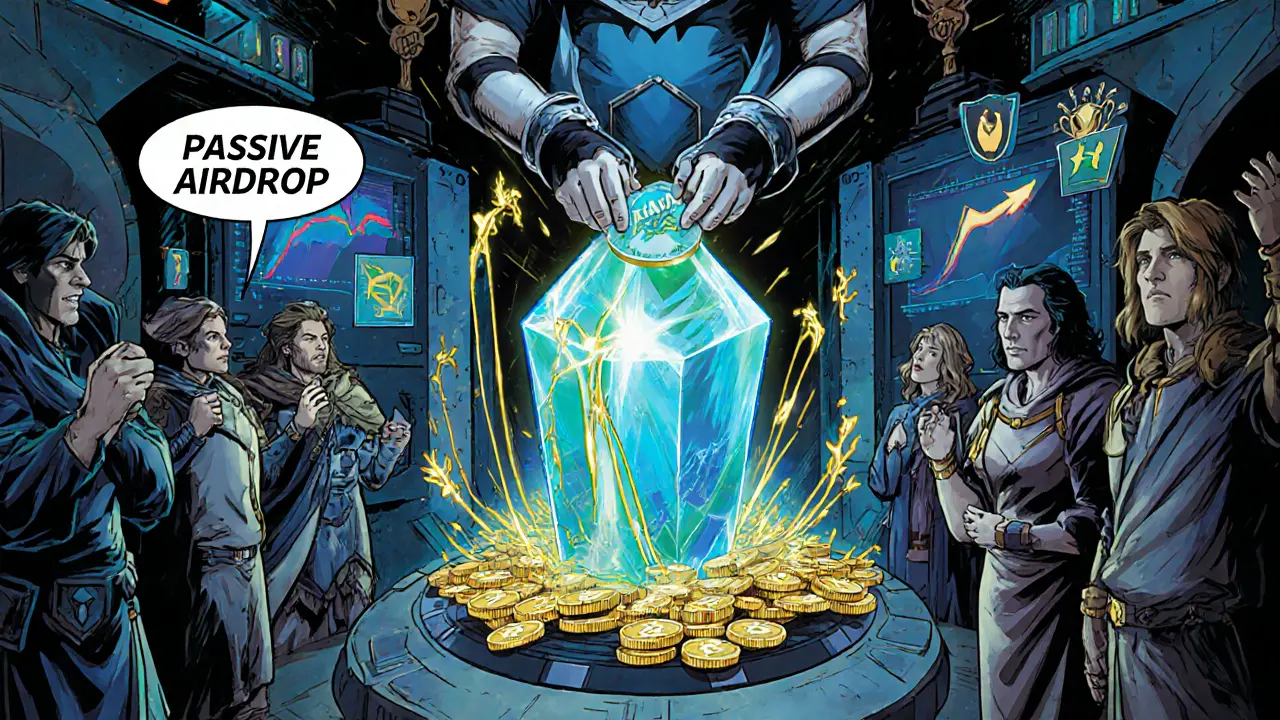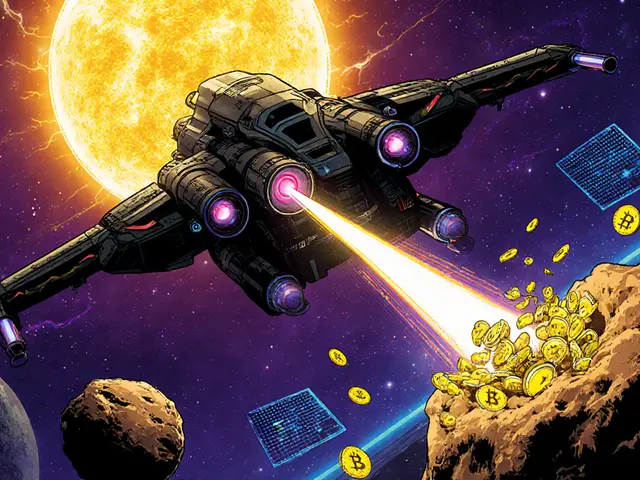- Home
- Cryptocurrency
- Rainmaker Games RAIN Token Airdrop Details 2025 - What You Need to Know

Rainmaker Games RAIN Token Airdrop Details 2025 - What You Need to Know
RAIN Token Airdrop Calculator
Staking Rewards
Estimate your passive RAIN earnings through staking.
Estimated Rewards: 0 RAIN
Participation Rewards
Calculate potential rewards from guild activity and events.
Estimated Rewards: 0 RAIN
Total Potential Rewards
Combine staking and participation rewards to estimate total potential earnings.
Note: These calculations are estimates based on current data. Actual rewards depend on platform performance, participation levels, and tokenomics changes.
When you hear the word "airdrop" you probably picture free crypto landing in your wallet. In the case of Rainmaker Games, the story is a bit more nuanced. The platform’s RAIN token didn’t sprout from a classic giveaway; instead, it emerged through a high‑speed Fair Launch Auction and a series of ecosystem‑driven rewards. This guide pulls together everything a gamer or investor needs to understand the token’s launch, the reality of any airdrop, and how you can stay in the loop for future opportunities.
Key Takeaways
- The RAIN token was sold in a $17million Fair Launch Auction on Copper Launch, not handed out for free.
- Yield‑bearing mechanics mean holders earn ongoing rewards, mimicking an airdrop over time.
- Future token drops are tied to platform participation, guild activity, and strategic partnerships.
- Understanding the tokenomics helps you decide whether to buy, stake, or wait for community events.
- Monitoring official Rainmaker channels is the safest way to catch legitimate airdrop announcements.
What Is the RAIN Token?
RAIN token is a yield‑bearing cryptocurrency designed for the Rainmaker Games ecosystem. It powers the platform’s reward system, grants voting rights on governance proposals, and unlocks premium features for “Rainmakers” - active gamers, guild leaders, and developers who contribute value.
Unlike many meme or utility tokens, RAIN generates a portion of platform revenue as passive income for holders. The token’s smart contract automatically distributes a slice of transaction fees, tournament entry fees, and in‑game purchases to wallets that stake RAIN.
How Was RAIN Distributed?
The most significant distribution event was a Fair Launch Auction a rapid, market‑driven token sale designed to ensure equal access for participants held on Copper Launch a DeFi platform that hosts token launches via auction mechanisms. Over three days in late 2023, the auction raised $17million, selling roughly 44million RAIN tokens at a price that fluctuated with demand.
Because the auction required participants to commit capital, there was no free‑for‑all airdrop. Instead, the mechanism aimed to democratize token ownership while preventing whales from hoarding the supply.
After the auction, the remaining tokens were allocated to ecosystem incentives, development funds, and strategic partners. This allocation includes a portion reserved for future community rewards that often resemble traditional airdrops.
Yield‑Bearing Mechanics: The “Passive Airdrop”
One reason the RAIN token feels like an airdrop is its yield‑bearing nature. Every time a player wins a tournament, purchases a skin, or completes a platform challenge, a tiny fee is routed to the RAIN smart contract. The contract then redistributes that fee proportionally to all wallets that have staked RAIN.
Effectively, you receive a steady stream of RAIN without buying more on the open market - similar to a dividend or airdrop that occurs every block. The more RAIN you hold and stake, the larger your share of the passive income.

Real Airdrops: When Do They Happen?
Rainmaker Games does run occasional airdrop‑style events, but they are usually linked to specific milestones:
- Game Launch Bonuses: When a new partner game like SolChicks a fantasy NFT and play‑to‑earn title built on Solana goes live on the platform, early adopters may receive a small packet of RAIN for testing the game.
- Guild Achievement Rewards: Guilds that hit volume thresholds (e.g., 10,000 total wins) can claim a pool of RAIN distributed among active members.
- Community Events: The platform’s Community Gaming an all‑in‑one tournament and payment solution for P2E titles partner often hosts seasonal tournaments where participants earn bonus RAIN.
All of these events require active participation, meaning the airdrop is more of a reward for engagement rather than a blanket giveaway.
Tokenomics at a Glance
| Category | Percentage of Total Supply | Purpose |
|---|---|---|
| Fair Launch Auction | 55% | Public sale to bootstrap liquidity |
| Ecosystem Rewards & Yield | 20% | Staking returns, tournament fees |
| Strategic Partnerships | 10% | Incentives for partners like SolChicks |
| Development & Treasury | 10% | Product upgrades, marketing |
| Team & Advisors | 5% | Retention and alignment |
The numbers above illustrate why the token never saw a classic airdrop: the majority of supply was sold to create market depth, while the remaining slices are earmarked for performance‑based incentives.
How to Qualify for Future RAIN Rewards
If you want to tap into the RAIN ecosystem without buying in the secondary market, focus on three pathways:
- Become a Rainmaker Guild Member: Join an active guild on the platform, contribute to weekly challenges, and you’ll earn a share of the guild’s RAIN pool.
- Stake RAIN Early: Once you own RAIN, lock it in the official staking contract. The longer you stake, the higher the annual percentage yield (APY), currently hovering around 12%.
- Participate in Partner Game Launches: Keep an eye on announcements from SolChicks and Community Gaming. Early testers often receive “beta‑airdrop” packets of RAIN.
All three methods are officially advertised on Rainmaker’s Discord, Twitter, and Medium channels. The company warns against unofficial “airdrop bots” that request private keys - legitimate drops never ask for that information.
Risks and Red Flags
Even a well‑structured ecosystem carries hazards. Here are the top concerns:
- Market Volatility: RAIN’s price can swing 30%+ in a week, especially after major platform updates.
- Reward Dilution: As more users stake, the APY may drop, reducing the effective “airdrop” value.
- Regulatory Uncertainty: Play‑to‑earn platforms are under growing scrutiny in jurisdictions like the US and EU. Future regulations could affect token utility.
- Centralized Control: Rainmaker Games holds a 10% treasury, which can be used for future development but also represents concentration risk.
Being aware of these factors helps you decide whether to hold, sell, or increase exposure.
Next Steps: Staying Informed
Because Rainmaker Games does not routinely issue blanket airdrops, the safest route is to stay plugged into their official communication channels:
- Discord: The #announcements and #rewards channels post real‑time updates on upcoming drops.
- Twitter (X): Follow @RainmakerGames for flash events and partnership news.
- Medium Blog: Monthly deep‑dives explain upcoming tokenomic changes.
Set up notifications, verify the source, and you’ll be first to hear about any RAIN‑related giveaways.

Frequently Asked Questions
Did Rainmaker Games ever run a free RAIN token airdrop?
No. The primary distribution method was a $17million Fair Launch Auction on Copper Launch. Subsequent token rewards are earned through staking, guild activity, and partner game events, which resemble airdrops but require participation.
How can I earn RAIN without buying it?
Join an active guild, stake any RAIN you already hold, or take part in early‑access launches from partners like SolChicks. Each activity allocates a share of the ecosystem rewards pool.
What is the current APY for staking RAIN?
As of October2025, the annual percentage yield hovers around 12%, but it fluctuates with the total amount staked and platform revenue.
Are there any scams pretending to be RAIN airdrops?
Yes. Scammers often create fake Twitter accounts or Discord servers asking for private keys. Rainmaker never asks for keys or upfront payments for an airdrop. Always verify through the official Rainmaker channels.
Where can I find the official RAIN token contract address?
The contract address is listed on Rainmaker’s official website under the "Token" section and is also verified on Solscan and Etherscan (depending on the network). Always double‑check the address before any transaction.
Cormac Riverton
I'm a blockchain analyst and private investor specializing in cryptocurrencies and equity markets. I research tokenomics, on-chain data, and market microstructure, and advise startups on exchange listings. I also write practical explainers and strategy notes for retail traders and fund teams. My work blends quantitative analysis with clear storytelling to make complex systems understandable.
Popular Articles
13 Comments
Write a comment Cancel reply
About
DEX Maniac is your hub for blockchain knowledge, cryptocurrencies, and global markets. Explore guides on crypto coins, DeFi, and decentralized exchanges with clear, actionable insights. Compare crypto exchanges, track airdrop opportunities, and follow timely market analysis across crypto and stocks. Stay informed with curated news, tools, and insights for smarter decisions.






Got the gist of the RAIN token overview – pretty solid write‑up. The fair launch auction model definitely keeps the whales at bay, which is a nice touch for newcomers. I’m also liking the yield‑bearing part; it feels like a built‑in airdrop for those who stake. Just make sure to keep an eye on the APY, it can shift with total staked volume. Overall, a good entry point for gamers looking to dip their toes in crypto.
The article does a decent job outlining the mechanics, but it glosses over the risk of reward dilution. As more users fling RAIN into staking pools, the per‑user payout inevitably shrinks – that’s basic economics. Also, the piece could have highlighted how the token’s price volatility has historically spiked after major game launches. Ignoring those factors gives a slightly rosy picture.
While the guide paints a captivating portrait of Rainmaker Games' tokenomics, it is essential to interrogate the ethical underpinnings of such a distribution model. The so‑called "fair launch auction" masquerades as egalitarian, yet it inherently privileges those with readily available capital, thereby perpetuating systemic inequities. Moreover, the promise of passive income through yield‑bearing mechanics risks luring inexperienced investors into speculative behavior under the guise of a benign airdrop. The narrative fails to address the environmental cost associated with blockchain operations, a factor that should be front‑and‑center in any responsible discourse. It also sidesteps the broader regulatory landscape, where jurisdictions worldwide are tightening around play‑to‑earn platforms, potentially jeopardizing token utility. The reliance on guild participation as a reward conduit introduces a gamified hierarchy that can marginalize solo players, further entrenching power asymmetries. While the article spotlights the token’s 12% APY, it glosses over the fact that such yields are not static and can erode as the staking pool expands. Additionally, the omission of a thorough risk assessment, especially concerning market volatility and token price manipulation, leaves readers without a full picture. In essence, the piece serves more as promotional material than a balanced analysis, and readers would be well advised to approach with a healthy dose of skepticism and due diligence.
To build on the earlier points, it is worth noting that the staking rewards are proportionate to the total revenue generated by the platform. Consequently, any decline in user engagement will directly impact the APY. Maintaining a diversified portfolio can mitigate exposure to such fluctuations.
Look, the whole "fair launch" hype is just marketing speak. If you’re not already deep‑pocketed, you’ll get left in the dust while the devs cash out. Grab the early‑access drops if you want a sliver, but don’t expect any real "free" RAIN unless you hustle hard in the guilds.
Sounds solid, will keep an eye on it.
Okay, let’s get real here – the ecosystem is designed to reward the most active participants, and that’s exactly what they want you to think is a "fair" distribution! If you’re not staking, joining guilds, or constantly grinding in partner games, you’re basically invisible to the reward system. The tokenomics look glossy on paper, but the reality is a relentless push for more engagement, more fees, and more capital from you. Stop buying into the euphemism of "passive airdrops" – it’s a carefully crafted funnel, and the only ones truly benefiting are the early investors and the dev treasury!
Bottom line: you either adapt or you get left behind.
The entire framework is a classic case of speculative engineering masquerading as community empowerment. By introducing yield‑bearing incentives, the platform effectively ties user retention to token value, creating a feedback loop that inflates perceived profitability. This is nothing more than a sophisticated pump‑and‑hold scheme, where early adopters reap benefits while later participants shoulder the downside risk. Furthermore, the reliance on external partnerships such as SolChicks introduces additional layers of dependency, making the token’s stability contingent upon unrelated project success. In short, the model is built on a house of cards that could collapse under any regulatory pressure or market correction.
All that talk about community rewards is just a smokescreen to keep the token price artificially high. Don’t be fooled.
From a philosophical standpoint, the notion of a token distributed via a "fair" auction raises profound questions about the nature of equity in digital economies. One might argue that true fairness necessitates not merely equal opportunity to purchase but also equitable access to the underlying value‑generating mechanisms. Yet the platform's reliance on active participation as a prerequisite for reward acquisition introduces a meritocratic element that may inadvertently marginalize less‑connected users. Moreover, the interplay between tokenomics and governance-where voting power is commensurate with token holdings-creates a feedback cycle that consolidates influence among the most affluent stakeholders. This dynamic warrants rigorous scrutiny, especially in light of burgeoning regulatory frameworks aimed at curbing concentration of power within decentralized ecosystems.
Oh great, another “reward” system that pretends to be inclusive while actually rewarding the same old elite. If you’re waiting for a miracle airdrop, you might as well keep refreshing your phone for a unicorn.
Hey folks, stay positive! Even if the token swings, the community vibe stays strong. Keep stacking those small wins and enjoy the journey.
Looks like another crypto project with buzzwords and no real substance. I’ll skim the docs later if I have time.